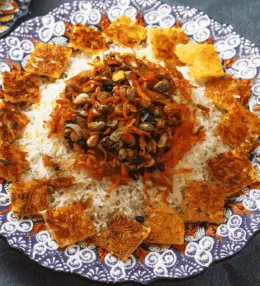
- View
Table of Contents
ToggleAloo Tama is a comforting curry from Nepal that showcases simple ingredients in a vibrant way. Potato and fermented bamboo shoots mingle in a spiced tomato broth that feels both hearty and refreshing. This dish brings warmth to chilly mountain evenings.
In many Nepali households this dish appears at gatherings and humble meals alike. It balances tangy and savoury notes with a silky texture that appeals across generations. Often prepared when bamboo shoots are in season it celebrates local produce. The harmony between spice and tang elevates every bite.
Savouring Aloo Tama is like sampling a slice of Nepalese culture itself. It invites you to savour contrasts: earthy potato softness against the brisk bite of bamboo. This curry is an invitation to explore Nepal without leaving your kitchen. Cooking it at home fills the kitchen with a homely fragrance that stirs nostalgia.
Want to dive deeper into Nepalese Cuisine? Don’t miss our post on 15 Traditional Nepalese Foods to Try
What Is Aloo Tama?
Aloo Tama is a soup style curry combining potato cubes and sliced bamboo shoots in a fragrant broth. Spices such as cumin, coriander and garlic infuse the liquid, creating layers of aroma. The fermentation of bamboo adds a subtle sour twist.
This meal straddles the line between stew and curry; it is lighter than some curries yet heartier than a soup. Coconut milk is rarely used, instead the focus lies on tomato and spices, making it distinctly Nepali. Its simplicity belies the complexity found in every tastebud awakening spoonful.
It is traditionally served with steamed rice or flatbreads like roti or sel roti (a sweet rice doughnut). Each spoonful of curry pairs perfectly with neutral starch, creating a harmonious mouthful that highlights every component. Leftovers deepen in flavour overnight, making it a practical dish for busy households.
Ingredients and Taste
Potatoes form the foundation, providing creamy comfort. Fermented bamboo shoots, known as tama, bring crunchy tang that contrasts the soft chunks. Tomatoes lend brightness while onions and garlic create an aromatic base. These humble elements illustrate how Nepali cuisine transforms basic staples into memorable meals.
Spices are kept simple: cumin, coriander, turmeric and chilli powder combine to produce gentle warmth. The fermentation of bamboo shoots adds that distinctive sour note which lingers pleasantly on the palate. Every pinch of spice is calibrated to complement rather than overpower.
The curry broth is softly spiced and slightly tangy with a vegetal depth. Creaminess from potatoes intertwines with the slight fizz of fermentation. The overall taste veers between rustic and refined, allowing each ingredient room to shine. For a milder version, some cooks substitute half the chilli powder with paprika.
A Taste of History
Aloo Tama took shape in the hilly regions of Nepal where potatoes thrive and bamboo forests abound. The Tamang community is often credited with its creation, using local harvests and age-old fermentation techniques to preserve shoots.
Fermenting bamboo shoots was a necessity once; it prevented waste and ensured food during off seasons. Over generations the recipe evolved into a celebrated comfort food, connecting families to their agrarian roots. As a result, Aloo Tama embodies resourcefulness, turning preservation into culinary art.
As Nepal modernised, Aloo Tama travelled beyond mountain villages, reaching city homes and restaurants. Today it represents both tradition and adaptability, showcasing how regional dishes can become national treasures. Modern chefs sometimes fuse it with influences from Indian and Tibetan cooking, showing its enduring versatility.

Nepali Aloo Tama (Potato & Bamboo Shoot Curry)
Ingredients
- 3 medium potatoes peeled and cubed
- 1 cup fermented bamboo shoots tama, rinsed and drained
- 1 cup cooked black-eyed peas or canned, drained and rinsed
- 1 large tomato finely chopped
- 1 small onion finely chopped
- 4 garlic cloves minced
- 1 inch fresh ginger grated
- 2 green chillies slit lengthwise
- 1 tsp turmeric powder
- 1½ tsp cumin powder
- 1½ tsp coriander powder
- ½ tsp fenugreek seeds
- 1 tsp red chilli powder adjust to taste
- ½ tsp garam masala optional
- 1 tsp salt adjust to taste
- 3 tbsp mustard oil or vegetable oil
- 1½ cups water
- Fresh coriander leaves chopped (for garnish)
- Juice of ½ lemon optional, for brightness
Instructions
- Begin by heating mustard oil in a deep pan until it reaches smoking point, then reduce the heat. Add fenugreek seeds and allow them to darken slightly without burning. This adds an authentic nutty bitterness typical of Nepali cuisine.
- Add chopped onions, garlic, and ginger to the pan. Sauté over medium heat until the onions turn golden and aromatic. Stir often to prevent sticking and ensure even browning.
- Toss in the chopped tomato and green chillies. Cook until the tomato softens and blends into the mixture. Use the back of your spoon to mash the tomato slightly for a thicker base.
- Sprinkle in turmeric, cumin, coriander, red chilli powder, and salt. Stir well and let the spices toast for 1 to 2 minutes. This step deepens the flavour and activates the spice oils.
- Add the cubed potatoes and mix thoroughly to coat them with the masala. Cook uncovered for 5 minutes, stirring occasionally to prevent burning and allow the spices to infuse into the potatoes.
- Pour in water and bring to a boil. Lower the heat, cover the pan, and let the potatoes simmer for 12 to 15 minutes or until just tender. Do not overcook, as they will continue to cook later with the bamboo shoots.
- Once the potatoes are tender, stir in the bamboo shoots and black-eyed peas. Let them simmer uncovered for another 10 minutes. The bamboo shoots will release their signature tang into the broth.
- Taste the curry and adjust seasoning. If you prefer a tangier finish, add a squeeze of lemon juice. For added warmth, stir in a pinch of garam masala at the end of cooking.
- Simmer uncovered for a final 5 minutes, allowing the curry to slightly thicken. Stir occasionally to ensure nothing sticks to the base of the pan.
- Turn off the heat and let the dish sit for a few minutes to settle the flavours. Serve hot, garnished with fresh coriander. Aloo Tama pairs beautifully with plain rice or roti and is best enjoyed piping hot with a spoonful of achar or a dollop of plain yoghurt on the side.
Nutrition
You May Also Like







Leave a Review